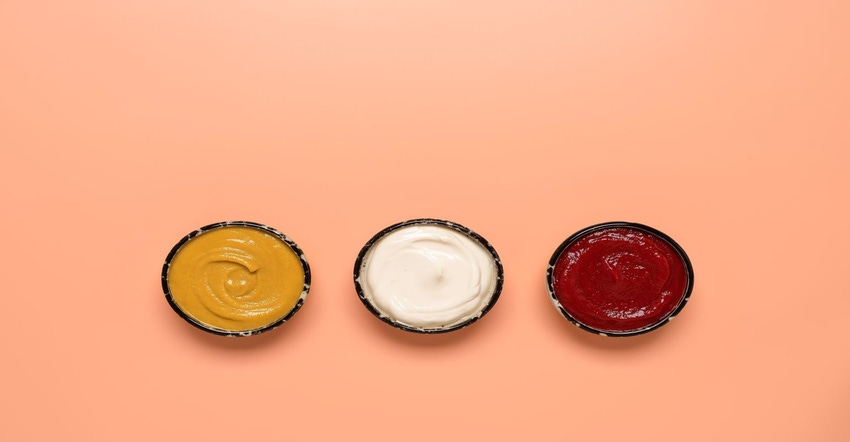Spreadable, dippable or pourable, condiment varieties are morphing from purely traditional to exotic with unique flavor and texture profiles.

Whether one prefers dipping fries in ranch dressing or ketchup, or spreading mayo instead of mustard on a sandwich, a condiment is available for every palate. Spreadable, dippable or pourable, varieties are morphing from purely traditional to exotic with unique flavor and texture profiles. Condiments are becoming healthier too, leading consumers to add them to a host of foods.
One of their great selling points, the versatility of condiments allows them a wide spectrum of applications. “Condiments can be used for dipping your favorite snacks, chips or vegetables; as a sauce or marinade for meat, fish or chicken; as a dressing for your salads and even as a cooking/seasoning aid for soups, stews and other dishes,” said Ron Pagaoa, senior marketing manager of the U.S. and Canada for the savory category at Ingredion Inc. “Consumers can use condiments to add flair, excitement and interest to just about anything.”
Traditional condiments like ketchup, mayonnaise and mustard are firmly entrenched in the market, according to Mintel’s report “Condiments - US - November 2019,” which noted “nearly universal penetration with over three-quarters of consumer engagement.” A survey published in the report asked consumers which condiments had been eaten at home in the last six months. The results revealed a preference for the classics: ketchup (84%), mayonnaise (78%), salad dressing (77%), mustard (77%) and hot sauce (58%).
Because of this widespread usage, these traditional condiments have struggled to find significant growth. “Consumer behavior for the rest of the category, however, paints a different picture, as consumption drops nearly 30% from traditional condiments to specialty ones, indicating that for many consumers their interest in the category starts and ends with traditional condiments,” the report stated.
However, generational differences play a part when it comes to condiment selection. SupHerb Farms’ 2021 Food & Beverage Trend Report indicated Boomers tend to show above-average affinity for more established sauces. The report described Gen X as adventurous eaters, and said Millennials love a wide range of global sauces, while Gen Z has “above-average affinity for numerous early-stage, less well-known global sauces and flavors.”
Becca Henrickson, marketing manager at Wixon, identified two big trends—versatility and a shift to more adventurous flavor types. She stated the latter is mainly being driven “by consumers 45 and younger who tend to be seeking new options when it comes to flavor. Where we see the biggest opportunity is new takes on familiar flavors. In particular, there is a large subset of people interested in flavors like asiago, bourbon, maple bacon, sesame ginger and raspberry chipotle.”
In terms of versatility, Henrickson finds that condiments positioned as more than just a dressing, dip, marinade or sauce are winning out over single-use sauces. “The majority of consumers use sauces for dipping, so playing up the convenience of a multi-use sauce will position for success in retail,” she said.
Looking at what flavors are emerging in sauces, she sees adventurous flavor-seekers gravitating toward harissa, gochujang, peri peri and togarashi. “However, health has also been a concern for consumers, and sauces with a health halo like apple cider vinegar do showcase equal interest across generations,” Henrickson continued.
Pagaoa has observed a surge in condiments in the past few years, especially during the COVID-19 pandemic, when people were preparing and eating most of their meals at home. “This has brought condiments to the forefront, as consumers look for variety in new flavor experiences and attributes,” he said.
Among the changes brought about by the pandemic, consumer interest in health and wellness is heightened. “Key recent trends include the incorporation of perceived healthy attributes and positioning, such as plant-based, vegan, gluten-free, organic, non-GMO and zero added sugars/low sugar,” Pagaoa said. “Special diets have also entered the condiments area, with new and growing product launches of keto-friendly/keto-certified and paleo sauces and dressings addressing consumers’ special dietary and lifestyle needs. Additionally, in the health and wellness area, we are seeing products with fermented-based condiments claiming digestive health and supporting immunity.”
As in other areas of the food sector, clean label is driving new product launches in condiments. Yeni Peña, Ingredion’s U.S. and Canada business development manager of clean and simple ingredients, noted significant increases in new products with clean label positioning, including natural, organic, non-GMO, and no additives or preservatives. “Clean label also can include ingredients with no E numbers, ingredients that you can find in your kitchen cupboard, or even a simple or shortened ingredient declaration,” she explained.
While food manufacturers and retailers such as Whole Foods have addressed customer concerns by creating their own “no-no” lists, a standard list doesn’t exist. Peña shared that Ingredion proprietary research reports “have shown that ingredient acceptability goes hand in hand with ingredient recognition.”
This excerpt is from the “Keeping condiments on top” deep dive, which covers all things condiments. Click the link to read it.
Cindy Hazen has more than 25 years of experience developing seasonings, dry blends, beverages and more. Today, when not writing or consulting, she expands her knowledge of food safety as a food safety officer for a Memphis-based produce distributor.
About the Author(s)
You May Also Like






